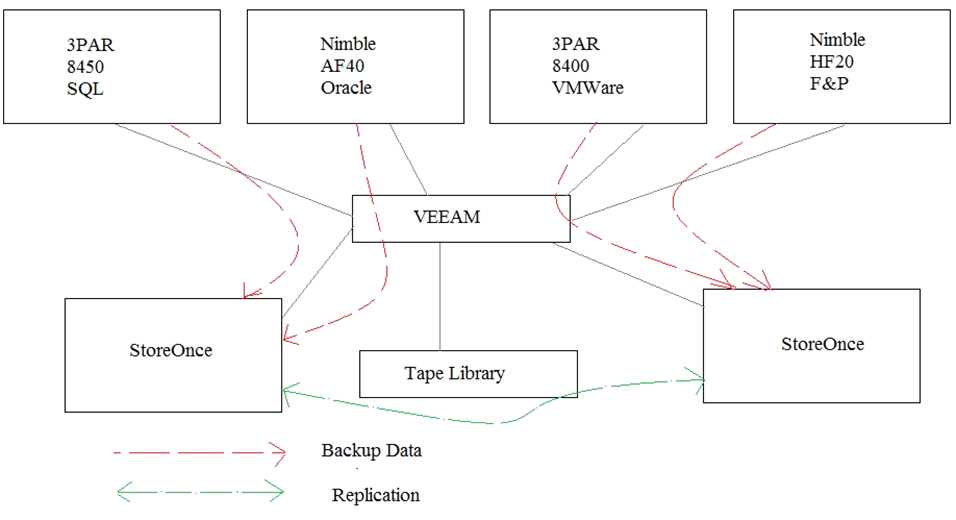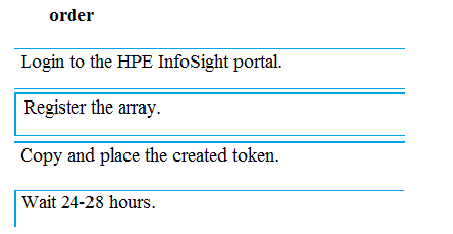HP HPE0-J58 Exam Questions
Questions for the HPE0-J58 were updated on : Jul 02 ,2025
Page 1 out of 7. Viewing questions 1-15 out of 95
Question 1
A startup company is considering an HPE Nimble solution. They have a small IT budget, and they
need to be future-proof for changing performance requirements. How does the Nimble architecture
meet the company needs? (Select two.)
- A. native support for block and file services
- B. minimal downtime technology refresh
- C. Support for FCoE
- D. non-disruptive technology refresh
- E. ability to mix-and-match All flash and hybrid nodes
Answer:
CE
Question 2
You are designing an HPE 3PAR replication solution for a customer in a metropolitan area that
includes two main sites and a third disaster recovery site. The main sites will be in synchronous
replication. The disaster recovery site can be asynchronously replicated.
What are two points you should highlight to the customer? (Select two.)
- A. Tertiary site volume paths are active/read only
- B. Quorum Witness at the third site enables automatic failover to tertiary site
- C. Secondary site volumes paths are active/optimized read/write
- D. Quorum Witness at the third site enables automatic failover to the secondary site
- E. Primary site volumes paths are standby read/write
Answer:
AD
Question 3
A customer has an HPE Nimble Storage array. They plan to add a second HPE Nimble Storage array to
their existing group.
What is the expected write behavior to a volume once the new array is added to the same pool as
the existing array?
- A. Data will be written to the new array until it is the same percent full as the original array
- B. Data will immediately start to alternate writes between the two arrays
- C. Data will continue to write to the first array until there is 40% free space available, and then alternate writes between the two arrays
- D. Data will be stripped and automatically re-balanced across the two arrays
Answer:
D
Question 4
A customer has three 4-node HPE 3PAR arrays. Two of the arrays are deployed at a primary site, and
the third array is deployed at a disaster recovery site. Both arrays at the primary site are replicated to
the single array at the disaster recovery site.
All replication is asynchronous periodic. All arrays are utilizing 4 RCIP links for replication.
The customer needs to add a third array at the primary site. They would like to use the existing array
at the disaster recovery site as a replication target for this additional array.
What must the architect consider to meet this customer requirement?
- A. A single pair of RCIP ports on one array can have a Remote Copy relationship with up to two other arrays
- B. Remote Copy fan-in ratios of greater than 2:1 are only supported with RCIP when using 10 Gb Ethernet links
- C. Arrays involved in a Remote Copy relationship must have the same number of node pairs
- D. Asynchronous streaming replication must be used for Remote Copy fan-in ratios greater than 2:1
Answer:
A
Question 5
A customer needs to setup specific replication bandwidth requirements to limit the bandwidth
between HPE Nimble Storage replication partners, which is different than the bandwidth
requirements to another Replication Partner.
Which Bandwidth parameter should the customer use?
- A. Array-to-array Limit
- B. Per-partner limit
- C. Partner Maximum limit
- D. Overall limit policy
Answer:
B
Question 6
You have chosen to utilize HPE 3PAR synchronous replication in order to meet the customer stated
requirement of RPO=0. What is a key consideration you need to explain to the customer?
- A. Host write latencies will decrease
- B. Host write latencies will increase
- C. Host writes can be committed to either primary or backup storage before host acknowledgment
- D. RC sync can only be deployed over FC links
Answer:
B
Explanation:
Reference:
https://support.hpe.com/hpsc/doc/public/display?docId=emr_naa00057870en_
us&docLocale=en_US(p.17)
Question 7
You are proposing a replication solution to a customer. A competitor offers a solution based on
storage
virtualization appliances.
What should you stress about an HPE 3PAR replication solution in regard to the competitors
proposal?
- A. It will add on-the-fly encryption and compression to data being replicated outside the customers DC
- B. It means less overhead for management and monitoring
- C. It offers best-in-class backup and restore capabilities
- D. It offers superior virtualization of 3rd party storage arrays
Answer:
B
Question 8
Refer to the exhibit.
A customer has the environment shown. They currently perform application-consistent daily full
backups via Veeam backup to an HPE StoreOnce device. These backups are then replicated to an
alternate device using Catalyst copy.
Changing business requirements have mandated the RPO and RTO for the customers SQL databases
be reduced to 15 minutes. Due to the size of the databases, it is not possible to meet this
requirement with their existing backout application.
What should you recommend the customer implement in order to meet their new requirement?
- A. HPE 3PAR Remote Copy in Synchronous Mode
- B. HPE RMC Express Protect
- C. SPE StoreOnce Cloud Bank
- D. HPE 3PAR Remote Copy in Asynchronous Streaming Mode
Answer:
B
Question 9
Which advantage is provided by HPE 3PAR Remote Copy across all replication modes?
- A. support of all Remote Copy topologies
- B. automatic recovery of array failure independent of Remote copy topology
- C. Remote Copy support up to 100ms latency over all transport layers
- D. all Remote Copy topologies yield identical RPO and RTO
Answer:
A
Explanation:
Reference:
https://manuals.directutor.com/3COM/4AA6-2851ENW/index.html?page=9
Question 10
DRAG DROP
Click and drag the steps on the left into the appropriate order on the right to set up an HPE 3PAR
array in InfoSight.
Answer:
None
Explanation:
Reference:
https://www.slideshare.net/CalvinZito/hpe-hpe-infosight-for-3par-quickstart-v14
Question 11
A customer has started to load their HPE 3PAR 8450 with data, but are not sure what data reduction
they are achieving. They ask you to run analysis and estimate the deduplication ratio of data
currently on a virtual volume (VV).
Which CLI command should you use to understand data reduction ratios?
- A. showvv
- B. tunevv
- C. convertvv
- D. checkvv
Answer:
D
Explanation:
Reference:
https://manualzz.com/doc/34471724/hpe-3par-adaptive-data-reduction
Question 12
A customer needs to new storage solution, including replication. The replication solution does not
need to provide an RTO or RPO of zero.
The customer suffers from severe VM sprawl and has experienced unidentified storage service-level
degradations.
What should you point out during your presentation of the solution?
- A. Hardware-assisted parity generation and deduplication mitigate the changing performance requirements
- B. VMs are always individually visible to the array with automatic enablement of VVOL technology
- C. InfoSight and VM details would help in identifying misbehaving VMs putting a high load on the array
- D. When a storage system is being overloaded, the replication software will automatically move the workload
Answer:
B
Question 13
A customer has HPE B-series switches and is not interested in Extended Fabric licenses for edge
switches.
They have sites over 10km apart.
Which SAN extension technology should you recommend?
- A. FC over DWDM
- B. FC over CWDM
- C. FCoE
- D. FCIP
Answer:
D
Explanation:
Reference:
https://h20195.www2.hpe.com/v2/GetPDF.aspx/c04499584.pdf
Question 14
How does the HPE Nimble Storage product strategy support a customers investment protection
requirements
for today and the future?
- A. by supporting replication with arrays from other vendors
- B. by supporting the implementation of third party cache, spinning media, and flash media
- C. by supporting replication between current and previous-generation array models
- D. by supporting the repurposing of obsolete array controllers as high-density servers
Answer:
B
Question 15
A customer has a pair of HPE 3PAR arrays with Synchronous Replication enabled. They need
recommendations for deploying the Quorum Witness when implementing Peer Persistence.
What should you recommend to the customer?
- A. The Quorum Witness should be in the secondary data center, with IP connectivity to the HPE 3PAR there
- B. The Quorum Witness should be in a third data center, with FC connectivity to both HPE 3PARs
- C. The Quorum Witness should be in the primary data center, with FC connectivity to the HPE 3PAR there
- D. The Quorum Witness should be in a third data center, with IP connectivity to both HPE 3PARs
Answer:
B
Explanation:
Reference:
https://h20195.www2.hpe.com/v2/GetPDF.aspx/4AA5-8914ENW.pdf